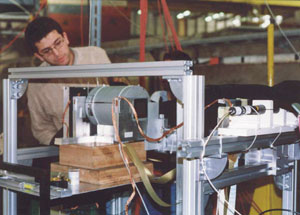
Transition radiation is playing an increasingly important role in the armoury of detection techniques for particle physics. A recent specialist workshop at Bari surveyed progress in this area.
When a fast-charged particle crosses the boundary between two media with different dielectric constants, the abrupt change in the electric field triggers the emission of electromagnetic radiation. If the particle energy is very high, the emitted photons are soft X-rays that can be collected easily.
Transition radiation was first predicted by V L Ginzburg and I M Frank in 1944, and in 1957 G M Garibian showed the feasibility of functional transition radiation detectors (TRDs). Since then TRDs have been successfully used in a number of experiments, mainly in high-energy particle physics and astrophysics.
Transition radiation has three major features that influence the design of these detectors:
* the total radiation energy emitted at the boundary is proportional to the particle’s Lorentz factor – the ratio of its total energy to its rest mass energy;
* the average number of photons emitted per boundary is rather small – about 1/137;
* the emitted photons travel in practically the same direction as the charged particle.
The first feature suggests two major applications – either to discriminate between particles with different masses and the same momentum or to measure the energy of a known particle.
The second feature means that, in order to have a significant number of photons, many boundaries are required. This can be achieved either by means of “regular radiators” built with many evenly spaced foils or with “irregular radiators” made of foams or fibres.
The third feature is something of a drawback, because the charged particle, if not deflected, releases energy by ionization in the same region as where the emitted photons must be detected: this effect requires careful design of the radiation detector and adequate data analysis techniques.
The Bari workshop examined the latest results and evaluated the future evolution of these detectors. The main subjects covered were the use of TRDs in currently operating experiments; the development of new concepts for radiators and radiation-detection devices; and the progress in engineering and electronics, mainly in view of high-rate accelerator experiments and high-performance set-ups to be operated on satellites.
After an overview by C Fabjan (CERN) on the renaissance of particle identification, K Ispiryan (Yerevan) gave a historical review of the pioneering theoretical and experimental steps in the field and later discussed the feasibility of a ring TRD, which is conceptually similar to a ring imaging Cherenkov detector.
M Cherry (Louisiana) gave a survey of applications in cosmic-ray and high-energy physics, and B Dolgoshein (Moscow) introduced new concepts for particle identification by TRDs. The installation and performance of a TRD in the future experiment AMS02 on the International Space Station was described by T Kirn (Aachen), while E O’Brien (Brookhaven), A Romaniouk (Moscow) and J Wessels (Heidelberg) presented, respectively, PHENIX, ATLAS and ALICE – the detectors to be included in large accelerator experiments.
A crucial TRD element is the X-ray detection device. F Gargano and M N Mazziotta (Bari) examined the possibility of using silicon detectors instead of the traditional gas chambers, while V Tikhomirov (Moscow) discussed the feasibility of a radiator/detector combination based on a two-component scintillator. D Cambiaghi (Brescia) talked about the mechanical design of instruments for a space environment.
The workshop paid attention to the process of the design, development and testing of TRDs, illustrated by several examples: from the GEANT simulations by P Nevski (CERN) to the design considerations for the transition radiation tracker (TRT) in ATLAS by H Danielsson (CERN) and the study of xenon-based gas mixtures by V Sosnovtsev (Moscow). The physics goals, trigger architecture and prototype tests of the TRD for the ALICE experiment were described by A Andronic (GSI-Darmstadt), B Vulpescu and V Angelov (Heidelberg).
TRDs also have valuable applications in cosmic-ray physics. F Loparco (Bari) presented the muon energy measurement performed by the TRD of the MACRO underground experiment, while F Cafagna and P Spinelli (Bari) showed the particle identification features of the TRD of the PAMELA satellite experiment.
The next workshop in the series is tentatively planned for May 2003.
The workshop was organized with the support of the Italian Institute for Particle Physics (INFN), the Italian Space Agency (ASI) and the physics department of Bari University and Polytechnic. The proceedings will be published by INFN-LNF SIS-Pubblicazioni.





